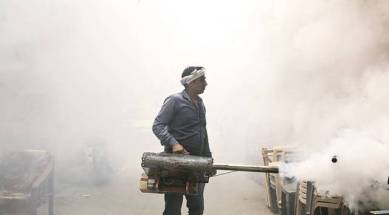Stay updated with the latest - Click here to follow us on Instagram
Malaria prevention efforts in state hit during pandemic; deaths increase by 104 pc in 2021
In Maharashtra, a total of 968 people succumbed to malaria between 2017 and 2021, according to data from the Public Health Department. This means that on an average, every month, 16 people die from the mosquito-borne disease in the state.

With all focus on SARS-Cov-2, efforts to control malaria had taken a backseat amid the Covid-19 pandemic. This is reflected in the data from the Maharashtra government that showed a 104 per cent surge in deaths related to malaria in 2021 compared to the pre-pandemic year of 2019.
While the Centre aims to make India malaria free by 2030, the Covid-19 pandemic had dealt a major blow to effective interventions. As the data shows, 185 deaths were registered due to malaria in 2017, which dropped to 125 the next year, in 2018. In 2019, 150 died due to malaria. However, in 2020, this number increased to 202 and the next year, when the pandemic continued, 306 people died of the disease.
In Maharashtra, a total of 968 people succumbed to malaria between 2017 and 2021, according to data from the Public Health Department. This means that on an average, every month, 16 people die from the mosquito-borne disease in the state.
Of the total 968 deaths, over 600 were registered among male patients. “The movement of men outside for work is more frequent than women, be it at construction sites or even agricultural land, which makes them more vulnerable to mosquito bites,” said a Health Department officer.
The same trend was observed across the globe as the number of malaria cases and deaths jumped in the pandemic. According to the World Health Organisation’s (WHO) ‘Malaria Report’, there were an estimated 6,19,000 malaria-linked deaths globally in 2021 and 6,25,000 in the first year of the pandemic, 2020. In 2019, before the pandemic struck, the number of deaths stood at 5,68,000.
Doctors attributed several reasons for the spike in malaria cases in 2020 and 2021, including the national lockdown, when patients couldn’t reach hospitals on time, lack of malaria preventive measures and insufficient testing. “In 2021, when Covid-19 restrictions were relaxed, with the rise in outside movement, the number of malaria cases also increased to around 20,000 from 12,000 reported in 2020 in Maharashtra,” said a health department officer focussing on malaria.
Another doctor said, “During the pandemic, due to some common symptoms with Covid-19, such as fever, many patients didn’t consult doctors from fear of getting quarantined, which contributed to the spread of the disease from the carriers.”
An age-wise analysis of malaria deaths by The Indian Express shows that most fatalities were among patients above 45. Also, although the number of deaths among children was low, a total of 67 children below the age of 15 lost their lives to malaria in Maharashtra.
Malaria is a mosquito-borne infectious disease that spreads when bitten by a mosquito infected by parasites. It becomes fatal when the disease affects multiple organs and its functions. “In severe cases, malaria parasites affect red blood cells, leading to rupturing of cells. This leads to complications in patients and affects their brain, kidneys and liver circulation. Thus, in some cases, patients die due to advancement in complications irrespective of the treatment given,” said Dr Kirti Sabnis, infectious disease specialist, Fortis Hospital.
Over 60 per cent of malaria deaths were reported in tribal districts – with Gadchiroli topping the list—as controlling the disease in forest and hilly areas is very difficult due to various socio-economical, geographical and ecological factors, including presence of abundant mosquito-breeding habitats. Other factors include cattle sheds attached to human dwellings, houses with mud walls, migration of people and the presence of asymptomatic carriers in the community.
Members of some tribal communities also avoid doctor visits because of superstitions, going to local ‘faith healers’ instead. “Due to this, most patients are hospitalised only after their health deteriorates. So, during our door-to-door testing, we have to accompany local leaders and gram sevaks to convince the villagers to take the medicines,” said Kalidas Raut, assistant health officer, Gadchiroli.